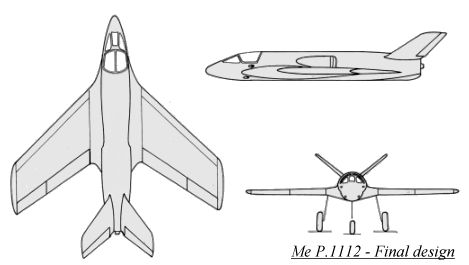 In early 1945, Messerschmitt began work on the P.1112,
which sought to eliminate design shortcomings from the
P.1111
project. The design went through many changes (see drawings below) in a short
time until the final form was reached. The project's final design featured
a 40 degree swept-back wing with a self-sealing fuel tank (250 kg- 550 lbs
weight capacity) in each wing. One fuel tank (550 kg-1210 lbs weight capacity)
was also located in the fuselage ahead of the engine, giving a total fuel
capacity of approximately 1900 liters (417 gallons) with a provision for
an increase to 2400 liters (527 gallons). A single He S 011A jet engine was
planned with provisions made to upgrade to the more powerful He S 011B engine
when it became available. Two air intakes were located on each side of the
fuselage above the wing roots. The tail unit was changed in the final design
to a smaller V-tail from a more conventional large single fin and rudder,
this helped to reduce the surface area and thus lessen drag. A tricycle landing
gear arrangement was decided upon, with the main gear having a wheel base
of 2.1 meters (6' 11") and retracting from the wing into the fuselage. The
pilot sat in a pressurized cockpit that was set well forward, with the canopy
being fully faired in to the fuselage. An ejection seat was also supplied
and the pilot was well protected by the sloping (23 degrees), 100mm (4 inch)
thick forward windshield, the side windows were 60mm (2.4 inch) thick. The
armament consisted of four MK 108 30mm cannon which were located on the fuselage
sides surrounding the cockpit. Two 30mm MK 103 cannon could be fitted in
place of two of the MK 108 cannon. A very unusual mounting of either one
MK 112 55mm cannon, mounted in the lower fuselage sides, or one Mk 214 50mm
cannon (see drawing below) could be accommodated by the barrel protruding
through the front canopy.
In early 1945, Messerschmitt began work on the P.1112,
which sought to eliminate design shortcomings from the
P.1111
project. The design went through many changes (see drawings below) in a short
time until the final form was reached. The project's final design featured
a 40 degree swept-back wing with a self-sealing fuel tank (250 kg- 550 lbs
weight capacity) in each wing. One fuel tank (550 kg-1210 lbs weight capacity)
was also located in the fuselage ahead of the engine, giving a total fuel
capacity of approximately 1900 liters (417 gallons) with a provision for
an increase to 2400 liters (527 gallons). A single He S 011A jet engine was
planned with provisions made to upgrade to the more powerful He S 011B engine
when it became available. Two air intakes were located on each side of the
fuselage above the wing roots. The tail unit was changed in the final design
to a smaller V-tail from a more conventional large single fin and rudder,
this helped to reduce the surface area and thus lessen drag. A tricycle landing
gear arrangement was decided upon, with the main gear having a wheel base
of 2.1 meters (6' 11") and retracting from the wing into the fuselage. The
pilot sat in a pressurized cockpit that was set well forward, with the canopy
being fully faired in to the fuselage. An ejection seat was also supplied
and the pilot was well protected by the sloping (23 degrees), 100mm (4 inch)
thick forward windshield, the side windows were 60mm (2.4 inch) thick. The
armament consisted of four MK 108 30mm cannon which were located on the fuselage
sides surrounding the cockpit. Two 30mm MK 103 cannon could be fitted in
place of two of the MK 108 cannon. A very unusual mounting of either one
MK 112 55mm cannon, mounted in the lower fuselage sides, or one Mk 214 50mm
cannon (see drawing below) could be accommodated by the barrel protruding
through the front canopy. ![]() Model photo of the Me P.1112
Model photo of the Me P.1112
![]() View Gino Marcomini's Me P.1112 Luft Art images
View Gino Marcomini's Me P.1112 Luft Art images
Span: 8.74 m (28' 8") Length: 8.25 m (27' 1") Max. Speed: 1100 km/h (683 mph)
| A cutaway
view of the P.1112 showing the location of the fuel tanks, jet engine and cannon 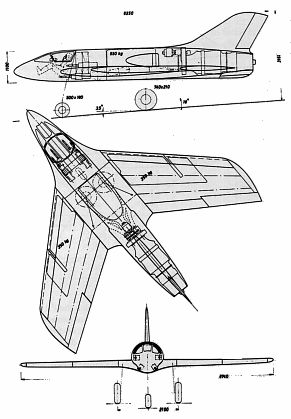
|
An original 1:10 drawing dated March
16, 1945 showing the placement of the MK 214 50mm cannon in the P.1112 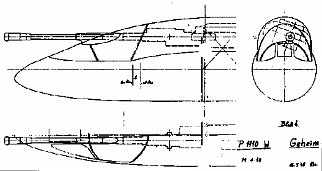
|
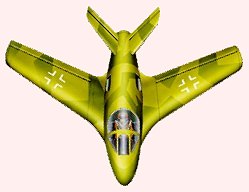
|
| Two photos
of the Messerschmitt Me P.1112 cockpit mock-up found at the Oberrammergau workshops by Allied troops on April 29, 1945. |
||
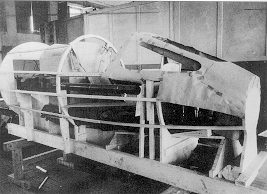
|
«Left Note the gun locations
behind the cockpit, with the gun barrels providing extra pilot protection.
Right» |
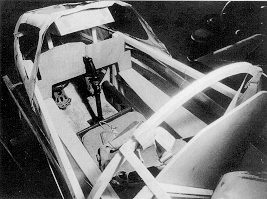
|
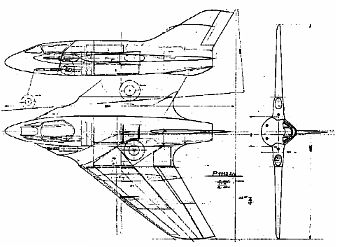
This sketch is dated March 3, 1945 and was arranged by Hans Hornung. Note the resemblance to the Me P.1111 wing and air intakes in the leading edge wing roots. |

This is a later updated sketch. Note the wing is still swept back at 45 degrees, but has a narrower chord, and the air intakes have been moved to the fuselage sides. |
| In this sketch, the wings have changed again, and are only swept back at 40 degrees. The air intake shapes have also been slightly altered. 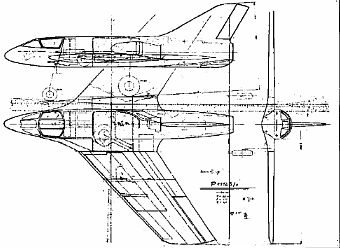
|
Although this final sketch is not fully finished, the final shape
of the P.1112 has taken shape, and the V-tail has been added. March 30, 1945 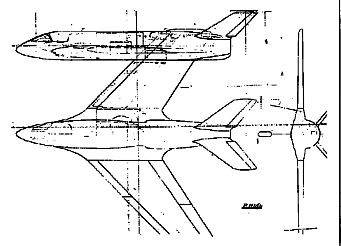
|